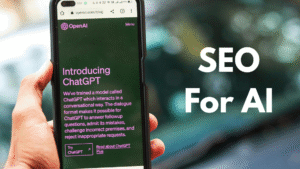Are your SEO tactics missing out on Generative Engine Optimization Hacks that drive AI and voice search visibility?
With the rise of AI chatbots like ChatGPT, Bing Copilot, and Google Gemini—and the increasing usage of voice assistants like Alexa and Siri—Generative Engine Optimization Hacks are no longer optional.
They’re essential.
In this in-depth guide, you’ll discover how to align your content with how modern users talk, search, and engage—not just how they type.
This blog isn’t a quick fix; it’s a deep dive for digital marketers, SEO strategists, and content creators aiming to lead in the AI-first era.
Let’s redefine your approach to discoverability.
What is Generative Engine Optimization (GEO)?
Generative Engine Optimization (GEO) is a modern approach to content optimization designed specifically for generative AI models and voice-based search engines.
Unlike traditional SEO—which focuses on ranking in search engine result pages (SERPs) through keywords, backlinks, and technical structure.
GEO is centered around making your content easily discoverable, interpretable, and promotable by AI systems such as ChatGPT, Google Gemini, Bing Copilot, and voice assistants like Siri, Alexa, and Google Assistant.
How GEO Differs from Traditional SEO
Here’s a breakdown of how Generative Engine Optimization differs from traditional SEO:
| Aspect | Traditional SEO | Generative Engine Optimization (GEO) |
|---|---|---|
| Focus | Ranking on Google SERPs | Visibility in AI-generated responses |
| Optimization Target | Search engine bots (crawlers) | AI models (ChatGPT, Bard, Gemini, Bing AI) |
| Query Format | Short keyword-based searches | Long-form, natural-language questions |
| Content Structure | Keyword-driven, meta-optimized | Conversational, Q&A structured, semantically rich |
| Discoverability | Through backlinks and page rank | Through relevance, clarity, and context |
| User Intent Handling | Informational, navigational, transactional | Informational, action-based, context-sensitive |
Why GEO Matters in 2025 and Beyond?
Search behavior has evolved dramatically in recent years.
Here are a few reasons why Generative Engine Optimization Hacks are becoming essential for digital marketers and content creators:
- Rise of AI Search Assistants
Tools like ChatGPT, Bing Copilot, and Perplexity AI now serve millions of queries daily. Many users no longer go to search engines; they simply ask an AI assistant. - Voice Search Domination
Voice searches account for a growing portion of all searches. These queries are typically longer, more natural-sounding, and context-specific—exactly the kind of queries generative engines handle best. - Zero-Click Search is the New Norm
In a zero-click environment, users get answers directly on the page or interface, never visiting your website. To be visible in this environment, your content must be structured for AI comprehension. - AI-Powered Summarization Engines
Google’s Search Generative Experience (SGE) and Bing AI don’t list websites—they summarize content into a synthesized paragraph. If your content isn’t GEO-optimized, it won’t make it into that summary.
Key Components of GEO
To understand Generative Engine Optimization in practice, consider these foundational elements:
- Conversational Formatting: Use headings framed as user questions, short paragraphs, and easy-to-read explanations.
- Structured Content: Incorporate schema markup (like FAQPage and HowTo), TL;DR summaries, and logical content hierarchy.
- Semantic SEO: Focus on context, meaning, and related terms—not just keywords.
- Voice Optimization: Write content that reads well out loud, targeting long-tail queries and natural speech patterns.
- AI-Trainable Language: Use language patterns that AI models are trained to recognize, including direct answers, definitions, and lists.
A Real-World Example
Let’s say someone asks ChatGPT:
“What are the top strategies for Generative Engine Optimization?”
Structure your blog with clear questions and concise answers to boost AI visibility—even without ranking #1 on Google.
What GEO Prioritizes?
Generative Engine Optimization is less about algorithmic rankings and more about semantic clarity, contextual relevance, and conversational formatting. Here are the core pillars:
- Answer-First Structure
Generative models want clean, well-structured answers. GEO content puts the answer up front—often in the first sentence or paragraph—and then elaborates with supporting details. - Conversational Language
AI tools like ChatGPT are trained on human dialogue. If your content mimics how people speak and ask questions, it’s more likely to be included in a chatbot’s response. - Semantic Richness
GEO goes beyond keyword stuffing. It emphasizes topical depth and clarity using related entities, synonyms, and real-world examples. It helps AI understand the “theme” of your content and choose it over shallow alternatives. - Structured Formatting
Using schema markup (e.g., FAQPage, HowTo, Article), bullet points, lists, subheadings, and TL;DR summaries makes it easier for AI models to scan and extract information. - Trust and Authority Signals
AI models are more likely to cite content that demonstrates authority through data, references, consistent tone, and clarity. GEO encourages linking to trustworthy sources and using evidence-based writing.
Advantages of GEO (Generative Engine Optimization)
Generative Engine Optimization (GEO) offers a future-proof way to ensure your content is discoverable, referenced, and trusted by modern AI-driven platforms.
As AI transforms the way people interact with information, GEO presents a competitive advantage that traditional SEO alone can’t deliver.
Here’s a detailed breakdown of the key advantages of GEO for digital marketers, brands, and content creators:
1. Increased Visibility in AI-Generated Responses
Unlike traditional SEO, which depends on ranking in search engine results pages (SERPs), GEO is about being selected by generative engines like ChatGPT, Bing Copilot, and Google Gemini.
These platforms generate synthesized responses from multiple sources, and GEO helps your content be one of those chosen few.
Why it matters:
Users may never scroll through search results—they’ll trust the AI’s answer. If your content is cited in that answer, you gain visibility even without ranking #1 on Google.
2. Better Alignment with Voice Search Trends
Voice searches are often full-sentence questions, like “How can I lower my electricity bill?” rather than keyword-based queries like “reduce electricity cost.”
GEO optimizes your content for this shift by using natural language, conversational formatting, and concise answers.
Why it matters:
Voice assistants like Alexa, Google Assistant, and Siri are becoming primary discovery tools. GEO ensures your content is formatted to provide spoken answers.
3. More Authoritative Brand Positioning
GEO encourages the use of structured formats (Q&A, TL;DR summaries, schema markup) and authoritative sources.
When AI tools detect your content is clear, well-referenced, and accurate, they are more likely to trust and use it.
Why it matters:
Being quoted or summarized by AI platforms reinforces your authority and expertise in your industry—even to people who don’t visit your site directly.
4. Higher Engagement from Human Readers
GEO’s focus on clarity and conversational tone doesn’t just appeal to AI—it also appeals to people.
Structuring content to directly answer questions, include bullet points, and provide quick takeaways leads to better reader engagement, reduced bounce rates, and improved time on page.
Why it matters:
Engagement metrics improve SEO and increase conversions. GEO helps content serve both machines and humans.
5. Optimized for Zero-Click Search Environments
With the rise of featured snippets, AI overviews, and chatbot integrations, many users never click through to a website.
GEO helps you own the answer space by making your content eligible for AI-generated summaries and voice responses.
Why it matters:
Zero-click searches are rising, and if your content isn’t structured for GEO, you’ll miss this growing traffic channel entirely.
6. Content Longevity and Scalability
GEO-optimized content is more evergreen because it’s designed to answer questions comprehensively.
When content is structured semantically and updated regularly, it maintains relevance longer and can be repurposed across formats like videos, voice scripts, and chatbot knowledge bases.
Why it matters:
One well-optimized piece of content can serve multiple platforms, devices, and AI engines—extending its reach and ROI.
7. Future-Readiness for AI-Powered Search Evolution
Search is evolving. Google, Microsoft, OpenAI, and others are investing heavily in AI-driven user experiences.
GEO prepares your content not just for today’s AI models, but for whatever comes next—like agent-based search, AI companions, and context-aware assistants.
Why it matters:
Brands that invest in GEO now will be far ahead when AI becomes the default interface for digital interaction.
8. Enhanced Discoverability Across Multiple Platforms
Generative AI doesn’t pull from just one source. It aggregates from blogs, FAQs, forums, product pages, and more.
GEO allows all your content types—not just your main site—to be eligible for AI citation.
Why it matters:
Your brand can appear across different verticals and answer types, improving omnichannel discoverability.
9. Reduced Dependence on Paid Ads
While paid advertising drives traffic, it comes at a cost.
GEO helps you build organic visibility in new-age search interfaces—offering a sustainable, long-term alternative to heavy ad spend.
Why it matters:
Less reliance on PPC means better ROI and stronger brand credibility over time.
10. Compatibility with Content Automation Tools
GEO principles—like structuring answers, using semantic keywords, and inserting schema—can be embedded into content templates and AI writing tools.
This makes it easier to scale your content strategy efficiently.
Why it matters:
You can produce high-performing content faster without sacrificing quality or search performance.
How GEO (Generative Engine Optimization) Works?
Generative Engine Optimization (GEO) makes your content discoverable and usable by AI tools like ChatGPT, Gemini, Bing Copilot, and voice assistants.
Unlike traditional SEO, which focuses on ranking pages in search engines.
GEO is about formatting and structuring content so it can be understood, summarized, and quoted by generative engines.
Here’s a detailed step-by-step breakdown of how GEO works:
Step 1: Understand the Nature of Generative Search
Before creating content, it’s crucial to understand how AI engines operate:
- They don’t display ranked links; they generate synthesized responses.
- They prioritize context, clarity, and trust over keyword density.
- They often use long-form questions as inputs (especially in voice search).
Goal:
You’re not optimizing for page 1 of Google—you’re optimizing to be part of the AI’s answer.
Step 2: Identify User Intent and Conversational Queries
GEO begins with question-first keyword research. Instead of just targeting “best CRM tools,” you’d target:
- “What are the best CRM tools for startups?”
- “Which CRM software integrates with Gmail?”
- “How does a CRM help small businesses grow?”
Use tools like:
- Google’s ‘People Also Ask’
- AnswerThePublic
- AlsoAsked
- Quora and Reddit threads
- ChatGPT-generated question clusters
Goal:
Map out natural language queries that reflect real user problems or intentions.
Step 3: Structure Content in Q&A or Conversational Format
Once you’ve identified the right queries, format your content for AI comprehension. Use:
- TL;DR blocks at the top
- FAQs mid-way or at the end
- Conversational subheadings (e.g., “How does this tool save time?”)
- Short, clear paragraphs and bullet points
Goal:
Make it easy for AI to extract, summarize, and reuse your content accurately.
Step 4: Provide Clear, Direct, and Credible Answers
Avoid fluff. AI models prioritize content that gets to the point.
Example:
Q: What is Generative Engine Optimization?
A: GEO is a method of optimizing content for AI tools and voice search platforms to ensure visibility in AI-generated responses.
Support your answers with:
- Examples
- Data
- Step-by-step instructions
- Trusted external links
Goal:
Help the AI answer user questions better by quoting you.
Step 5: Use Semantic and Contextual Keywords
Don’t obsess over one exact-match keyword. Instead, use semantically related terms and natural phrasing.
For “Generative Engine Optimization,” include:
- AI search optimization
- Voice assistant visibility
- Generative search strategies
- AI content citation
Goal:
Train AI that your content is topically rich and contextually relevant.
Step 6: Implement Schema Markup and Structured Data
Use structured data to help both traditional and AI-based engines understand the layout and purpose of your content.
Uses:
- FAQ schema
- Article schema
- HowTo schema
- Breadcrumb schema
Use Schema.org or plugins like Yoast SEO or Rank Math to automate this.
Goal:
Give AI an additional layer of structured clarity to interpret your content correctly.
Step 7: Refresh Content Regularly for Relevance
AI models and search engines favor up-to-date information.
Set a schedule to:
- Update stats and sources
- Rephrase old sections in current language
- Add new FAQs based on user trends
Goal:
Stay “fresh” in the eyes of both AI tools and users.
Step 8: Interlink Content Internally and Cite Authoritative Sources
Use internal links to guide AI (and human readers) across your website, and cite trusted sources externally (e.g., government, research sites, major media).
Goal:
Build trust and improve the chance of being selected for AI-generated answers.
Step 9: Optimize for Voice Search and Readability
Voice assistants need answers that:
- Are short (30 seconds or less)
- Are easy to pronounce
- Contain natural pauses and rhythm
- Avoid complex jargon
Use tools like Google Text-to-Speech to test your content’s voice compatibility.
Goal:
Make your content the best candidate for voice output by assistants like Siri or Alexa.
Step 10: Track AI Traffic and Feedback
To ensure your Generative Engine Optimization (GEO) efforts are effective, you must track how your content performs across AI-powered platforms.
Start by using tools like:
- Google Search Console – Track impressions, clicks, and keyword performance, especially for content picked up in featured snippets or rich results.
- Bing Webmaster Tools – Offers insights into visibility on Bing, which directly feeds Bing Copilot and ChatGPT through Microsoft integration.
- Perplexity.ai Referrals – Check your analytics tools for new referral sources like Perplexity.ai, an emerging generative search platform.
Additionally, use web analytics platforms like Google Analytics 4 (GA4) to monitor user behavior and engagement on your AI-optimized pages.
Look for patterns such as increased dwell time, lower bounce rates, and high scroll depth—all signs that your structured, conversational content is resonating.
Goal:
Monitor whether your content is getting surfaced and improve based on real-world engagement.
Let’s explore 7 Generative Engine Optimization Hacks to Dominate Voice & AI Search.
7 Generative Engine Optimization Hacks to Dominate Voice & AI Search
1. Build a Q&A-Based Content Strategy
The foundation of effective Generative Engine Optimization (GEO) begins with building a Q&A-based content strategy.
Instead of focusing solely on keywords like “SEO trends” or “marketing automation,” you should target question-based queries such as:
- “What are the top SEO trends in 2025?”
- “How does marketing automation improve lead generation?”
- “Which tools help optimize content for ChatGPT?”
These types of queries align with how users naturally phrase their searches, especially through voice assistants or chatbots.
The goal is to anticipate the questions your audience is asking and then create content that answers those questions clearly, concisely, and conversationally.
How to Build a Q&A-Based Strategy
- Use Question Discovery Tools:
Platforms like AnswerThePublic, AlsoAsked, and Google’s “People Also Ask” box are goldmines for real user questions. - Create Question-Focused Headings:
Structure your blog posts and website content using questions as H2s and H3s. For example, instead of using “Benefits of GEO,” use “What Are the Benefits of Generative Engine Optimization?” - Answer Directly Under Each Question:
Start each section with a clear and concise answer. Follow it with supporting details like examples, stats, or bullet points. - Incorporate FAQs:
Add a Frequently Asked Questions section at the end of your posts. These are favored by AI models and often extracted for featured snippets. - Use Schema Markup:
Add FAQ schema to help AI and search engines identify and extract your Q&A content effectively.
Why It Works
AI models prefer Q&A formats because they mimic human conversation, making your content easier to understand, summarize, and feature in AI responses.
It’s a simple yet powerful way to align your content with how people search and how AI delivers answers.
2. Create AI Summaries (TL;DRs) at the Top
Including a concise AI-friendly summary at the top of your content—often called a TL;DR (Too Long; Didn’t Read)—helps AI models quickly grasp your page’s main value.
Since generative engines like ChatGPT, Bard, and Gemini prioritize direct, easily digestible answers, a well-structured TL;DR improves your chances of being selected for summaries or featured snippets.
The ideal TL;DR:
- Clearly answers the user’s query in 2–4 sentences.
- Includes the main keyword and related terms naturally.
- Avoids fluff and focuses on clarity, action, and relevance.
Think of it as a quick elevator pitch for both users and AI.
It sets the tone, delivers the core message fast, and encourages deeper reading while improving visibility in generative search results.
What You Should Do:
- Start with a 2–3 sentence summary at the top.
- Use the focus keyword “Generative Engine Optimization Hacks” naturally.
- Keep it clear, contextual, and value-packed.
Why It Works:
Summarization-based AI systems prioritize upfront context. A strong TL;DR block increases visibility in AI-generated responses.
Pro tip: Trigacy adds TL;DR blocks as part of their standard content framework.
3. Focus on Semantic Richness Over Keyword Density
In traditional SEO, keyword density—how often a particular phrase appears in content—was a central metric.
But in the age of Generative Engine Optimization (GEO), semantic richness plays a much more vital role.
AI models like ChatGPT, Gemini, and Bing Copilot don’t rely on exact keyword matches. Instead, they understand language contextually.
AI prefers content that explains topics clearly using related terms—not just repeating the same keyword.
For example, if your topic is “voice search optimization,” semantically rich content would also include related terms like:
- conversational queries
- voice assistants
- natural language processing
- mobile voice search behavior
- long-tail queries
The goal is to teach the AI what your content is about, not just trigger it with a specific phrase.
This helps AI models understand the scope and depth of your content, improving its chances of being summarized or cited in generative responses.
Tip: Use tools like Google’s NLP API or LSIGraph to find semantically related terms that enhance your content naturally and contextually.
4. Use High-Authority Sources and Citations
Schema markup is a type of structured data that helps search engines and AI models better understand the content on your website.
By using schema (also known as JSON-LD or microdata), you provide explicit context about your content—such as whether it’s a product, FAQ, article, review, or recipe.
In the context of Generative Engine Optimization (GEO), schema markup plays a vital role.
AI models like ChatGPT and Google Gemini often rely on clearly labeled data to generate accurate and relevant summaries.
Adding FAQ schema, How-To schema, and Article schema can dramatically improve your chances of being selected as a source in AI responses.
Structured data boosts rich results like featured snippets and knowledge panels, increasing clicks and strengthening your credibility with AI models.
Best practices include:
- Mark up FAQs with FAQPage schema.
- Use Article or BlogPosting for long-form content.
- Apply HowTo for step-by-step guides.
- Validate schema using Google’s Rich Results Test.
Schema markup isn’t just for SEO—it’s a bridge between your content and AI understanding.
5. Leverage Schema Markup and Structured Data
While traditional in SEO, structured data now fuels AI comprehension too.
What You Should Do:
- Implement FAQ schema, HowTo schema, and Article schema.
- Use JSON-LD for better integration with search engines.
- Add breadcrumbs and metadata consistently.
Why It Works:
It gives AI models a clearer understanding of your content, layout, and intent. Structured data is like GPS for AI.
Trigacy automates structured data injection into your CMS to scale this across all content.
6. Optimize for Voice Search Scenarios
Voice search changes content interaction—users now ask full, conversational questions instead of short keywords, like “How do I improve SEO for AI tools?”.
As a result, optimizing for voice search requires a shift in how content is created and structured.
To succeed in voice search, your content should use natural language and mimic how people speak.
That means crafting headlines, subheadings, and answers that sound like real conversation—not robotic keyword stuffing.
Additionally, make sure your pages load fast and are mobile-friendly, since most voice searches happen on mobile devices.
Structured data like FAQ schema also helps voice tools find and deliver your content accurately.
Voice search optimization is essential for GEO, ensuring your content is accessible, conversational, and favored by AI assistants like Siri and Alexa.
7. Update, Repurpose, and Train AI with Your Content
Content needs to evolve with AI models.
What You Should Do:
- Refresh blogs regularly with recent updates and stats.
- Repurpose blogs into LinkedIn carousels, Instagram Reels, and YouTube Shorts.
- Use fine-tuned AI (e.g., custom GPTs) trained on your content for internal use.
Why It Works:
Fresh content stays relevant and AI-visible. Repurposing expands reach across multiple AI-indexable formats.
Trigacy’s AI & content teams collaborate to ensure your content isn’t just fresh—but everywhere.
Don’t Think of GEO as Optional—It’s Foundational
GEO isn’t a replacement for SEO. It’s the evolution of it.
If SEO is about optimizing for search engines, GEO is about optimizing for answers.
Brands that master both will dominate discoverability in the AI-first world.
With Trigacy’s hybrid approach combining automation, human strategy, and cutting-edge content, clients see consistent visibility on both search results and generative summaries.
How Trigacy Helps with Generative Engine Optimization (GEO)?
Trigacy is at the forefront of the AI-first content era, helping brands adapt and thrive through smart, scalable GEO strategies. Here’s how we support your success:
- AI-Optimized Content Creation
We craft question-led, conversational content that aligns with how users interact with AI and voice assistants. - Structured Data & Schema Implementation
Our team adds FAQ, HowTo, and Article schema to boost AI readability and increase chances of being featured in summaries. - Voice Search Optimization
We ensure your content is natural, mobile-friendly, and voice-ready—ideal for Siri, Alexa, and Google Assistant. - Smart Repurposing
Blogs become carousels, Reels, Shorts, and chatbot inputs—maximizing reach across formats AI engines pull from. - AI-Training and Custom GPT Integration
We help train AI tools on your content (e.g., for internal chatbots or custom GPTs), making your knowledge base smarter. - Content Refresh & Scalability
Our workflows ensure your content stays fresh, relevant, and visible across both search engines and generative platforms.
Result:
Increased visibility. Higher authority. Future-ready content—built for both humans and machines.
Want to see GEO in action for your brand? Trigacy’s team is ready.
Conclusion
The way people find and consume information is evolving—fast.
As AI chatbots and voice assistants increasingly become the front door to the internet, traditional SEO alone is no longer enough to keep your brand visible, trusted, and discoverable.
Generative Engine Optimization (GEO) isn’t just a trend—it’s the strategic foundation for the AI-first era of content.
Shift from keywords to conversations, ranking to relevance, and clicks to comprehension to lead in the AI-driven search era.
Whether you’re a digital marketer, content strategist, or founder, adopting GEO now means future-proofing your visibility across every emerging search interface.
Need help implementing GEO? Trigacy’s experts are already doing it. Let’s talk.
FAQs
Q. What tools help with GEO?
A: SurferSEO (for on-page GEO analysis)
- Frase.io (for AI-driven topic research)
- WordLift (for semantic and schema markup)
- Trigacy’s proprietary content audit system
Q. Can GEO help local SEO?
A: Yes. Using conversational queries like “Where can I find… near me?” works extremely well for voice search and mobile AI queries.
Q. What’s the ROI of GEO?
A: Higher AI-citation visibility = more brand reach = better lead-gen and authority. Trigacy clients report increased traffic from AI sources after implementing GEO tactics.
Written by Priyanka Velhal from Trigacy.







